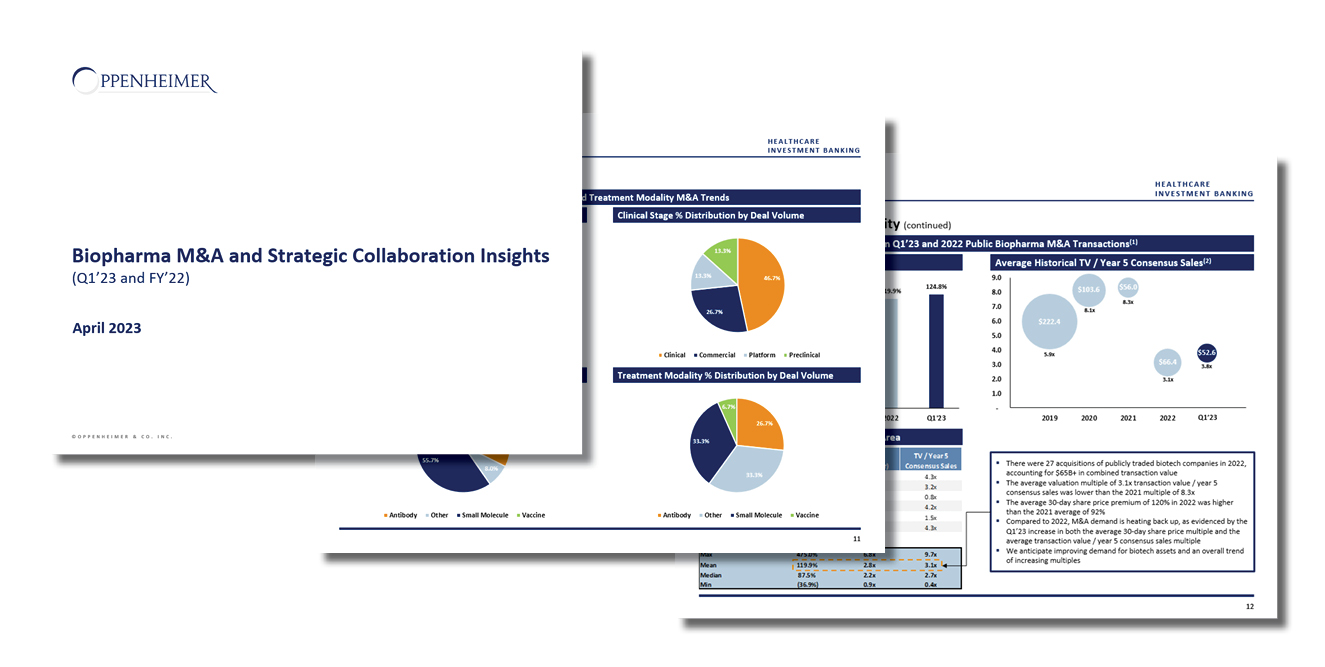The latest edition of Oppenheimer & Co. Inc.’s Quarterly Biopharma M&A and Strategic Collaboration Insights Report is now available upon request.
There are a multitude of viable reasons why Biopharma companies turn towards M&A, and no two deals are ever the same. We analyze key sector and transaction trends for 2022 and YTD2023 and elucidate some commonalities and differences.

Keypoints:
Current State of the M&A and Strategic Collaboration Market
- 2023 Biopharma M&A has started off strong with the $43.0B acquisition of Seagen and several $1B+ acquisitions including Provention Bio and Cincor
- Momentum continues into Q2’23 as Merck cashes in on Prometheus Biosciences for $10.8B and GSK acquires BELLUS Health for $2.0B
- Biopharma M&A activity reached all-time highs between 2019 and 2020, yet slowed substantially during 2021 and 2022, contrary to bullish expectations from the Street
- Looking back, deal volume in 2022 was up overall YoY due to a flurry of mid-to-late year acquisitions; however, transaction values were relatively nominal
- 2022 ended on a high note via the $28.3B acquisition of Horizon Therapeutics and Takeda’s acquisition of Nimbus Therapeutics’ TYK2 inhibitor for $5.0B
- Every big pharma company has a unique risk appetite that caters to company specific needs: commercial stage, early clinical, vs. preclinical assets
- Recent trends in acquisitions point to green lit commercial drugs, or close-to-market assets that can immediately fill revenue gaps
- This diverse risk appetite has yielded a shift away from strictly M&A, and towards strategic collaboration deals
- Preclinical assets continue to be high demand targets for collaboration deals as innovation continues for novel treatment modalities
Deal Catalysts
- Excess cash reserves at big pharma and large biotech
- Steep and fast-approaching patent cliff for big pharma
- Mega-blockbusters set to lose exclusivity over the next six years represent the biggest threat to commercial drug sales in decades
- Three drugs facing near-term loss of exclusivity have generated $50.3B in combined LTM(1) global revenues alone: AbbVie’s Humira ($21.2B), Merck’s Keytruda ($20.9B) and BMS’ Opvido ($8.2B)
- A challenging IPO market underpinned by low biotech valuations
- Profound clinical data and positive newsflow
- Declining COVID-19 vaccine revenue
Deal Headwinds
- Ambiguous macroeconomic outlook coupled with rising costs / inflation concerns
- An increasingly less predictable FDA
- Fragile supply chains and escalating costs of talent / human capital
- Decreasing risk appetite to take on early-stage programs whose funding requirements will eat into profits
- Bottom line P&L impacts from the new drug price negotiation legislation beginning in 2026 signed in to law through the IRA
- Increased FTC scrutiny (e.g. FTC issued Opinion and Order for Illumina / Grail)
Please reach out to Michael Margolis, R.Ph. ([email protected]), Daniel Parisotto, PhD ([email protected]), or Robert Lewis ([email protected]) directly to request a copy.

Michael A. Margolis, R.Ph.
Title:Senior Managing Director, Co-Head of Healthcare, Head of Healthcare Life Sciences
DISCLOSURES
This notice is provided for informational purposes only, and is not intended as a recommendation or an offer or solicitation for the purchase or sale of any security or financial instrument. Nothing contained herein shall constitute an offer or solicitation to buy or sell any securities discussed herein in any jurisdiction where such offer or solicitation would be prohibited.
This notice may contain statistical data cited from third-party sources believed to be reliable, but Oppenheimer & Co. Inc. does not represent that any such third-party statistical information is accurate or complete, and it should not be relied upon as such. All market prices, data and other information are not warranted as to completeness or accuracy and are subject to change without notice.
2023 Oppenheimer & Co. Inc. Transacts Business on all Principal Exchanges and Member SIPC 5642090.1

